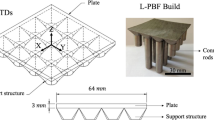Abstract
The generation of the grinding wheel topography is described in many different models and approaches. These models do not consider the influence of the dressing process on the wear of the grinding wheel. In particular the prediction of this wear dependent on the dressing process parameters is not possible with the currently available models. This article describes a novel model for the initial wear of vitrified bonded grinding wheels on the basis of Linke’s dressing model. Therefore, the load of the grinding wheel in dressing process is depicted using the mean dressing chip cross section, which is then used to model the wear of the grinding wheel. An analytical-empirical model for the initial radial grinding wheel wear in dependence of the load in dressing process is presented. Furthermore, the influence of the load in the dressing process on the wear mechanisms of the grinding wheel, in particular on the relative frequency of the fracture phenomenon grain break-out, is shown. The new model allows the prediction of the wear of the grinding wheel as a function of the geometric-kinematic engagement in dressing processes using the mean dressing chip cross section.





Similar content being viewed by others
References
Marinescu ID, Row WB, Dimitrov B, Inasaki I (2004) Tribology of abrasive machining processes. William Andrew Inc., ISBN 0-8155-1490-5
Brinksmeier E, Aurich JC, Govekar E, Heinzel C, Hoffmeister H-W, Peters J, Rentsch R, Stephenson D-J, Uhlmann E, Weinert K, Wittmann M (2006) Advances in modelling and simulation of grinding processes. Ann CIRP 55:667–696
Denkena B, Köhler J, Woiwode S (2014) Dressing of vitrified bonded CBN tools for continuous generating grinding. Prod Eng Res Dev 8:585–591
Schmitt R (1968) Abrichten von Schleifscheiben mit diamantbestückten Rollen. Dissertation, TU Braunschweig
Klocke F, Linke B (2008) Mechanisms in the generation of grinding wheel topography by dressing. Prod Eng Res Dev 2:157–163
Uhlmann E, Hochschild L (2013) Tool optimization for high speed grinding. Prod Eng Res Dev 7:185–193
Busch DM, Prins JF (1962) A basic study of the diamond grinding of alumina, the science of ceramic machining and surface finishing. National Bureau of Standards Special Publication, p 348
Tönshoff HK, Friemuth T, Hessel D (2001) Crushing process for vitreous bonded CBN and diamond grinding wheels. Prod Eng Res Dev 8(1):13–16
Liebe I (1996) Auswahl und Konditionierung von Werkzeugen für das Außenrund-Profilschleifen technischer Keramiken. Dissertation, TU Berlin
Doman DA, Warkentin A, Bauer R (2006) A survey of recent grinding wheel topography models. Int J Mach Tools Manuf 46:343–352
Malkin S (1989) Grinding technology—theory and applications of machining with abrasives. Elli Horwood Limited, Ckichester
Shaw MC (1996) Principles of abrasive processing. Clarendon Press, Oxford, pp 144–163
Linke B (2007) Wirkmechanismen beim Abrichten keramisch gebundener Schleifscheiben. Dissertation, RWTH Aachen University
Linke B (2008) Dressing process model for vitrified bonded grinding wheels. Ann CIRP - Manuf Technol 57:345–348
Klocke F, Thiermann J, Weiß M (2013) Abrichtprozess bestimmt den Schleifscheibenverschleiß - Einfluss der Belastung im Abrichtprozess auf das Verschleißverhalten der Schleifscheibe. wt Werkstattstechnik online 103(6):488–492
Wegener K, Hoffmeister H-W, Karpuschewski B, Kuster F, Hahmann W-C, Rabiey M (2011) Conditioning and monitoring of grinding wheels. Ann CIRP 60:757–777
Brinksmeier C, Çinar M (1995) Characterisation of dressing processes by determination of the collision number of the abrasive grits. Ann CIRP 44:299–303
Werner G (1971) Kinematik und Mechanik des Schleifprozesses. Dissertation, RWTH Aachen University
Klocke F, Gröning H (2003) Characterization of vitrified bonded cBN grinding wheels. Prod Eng Res Dev 12(2):15–18
Acknowledgments
The authors would like to thank the German Research Foundation (DFG) for funding the research project “Quantitatives Modell des Abrichtens von keramisch gebundenen Schleifscheiben” (KL 500/99-1).
Author information
Authors and Affiliations
Corresponding author
Rights and permissions
About this article
Cite this article
Klocke, F., Thiermann, J. & Mattfeld, P. Influence of the dressing process on grinding wheel wear. Prod. Eng. Res. Devel. 9, 563–568 (2015). https://doi.org/10.1007/s11740-015-0606-y
Received:
Accepted:
Published:
Issue Date:
DOI: https://doi.org/10.1007/s11740-015-0606-y




